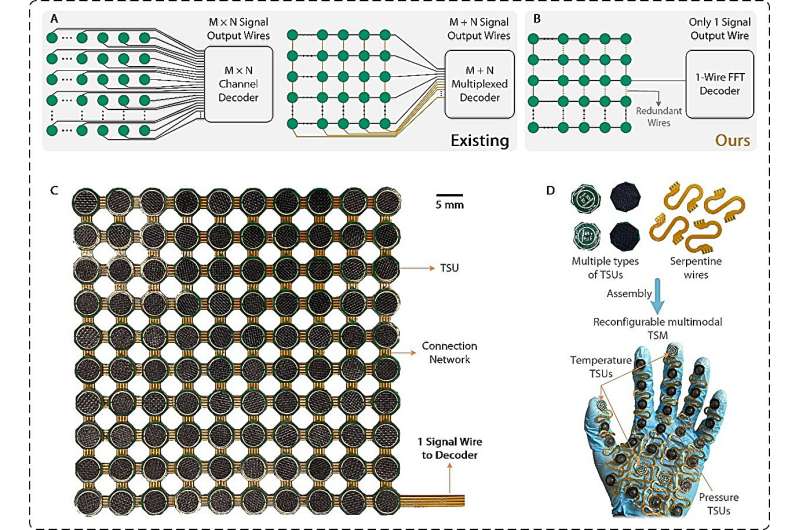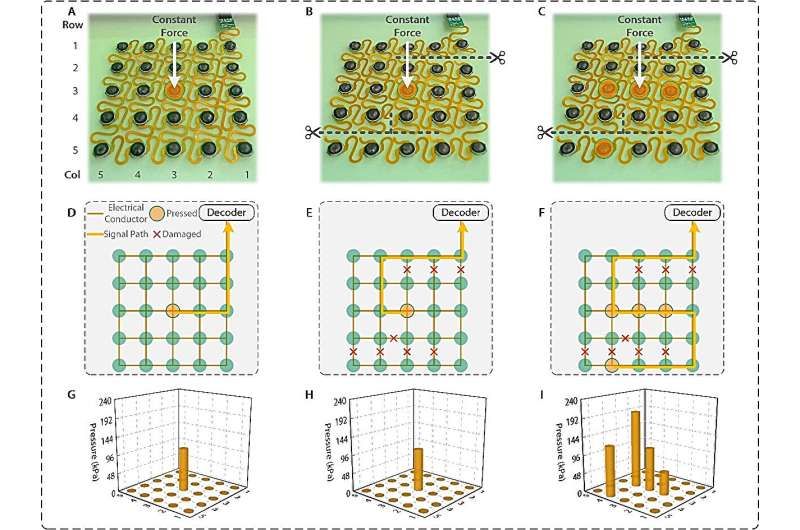This article has been reviewed according to Science X's editorial process and policies. Editors have highlighted the following attributes while ensuring the content's credibility:
fact-checked
peer-reviewed publication
trusted source
proofread
Researchers develop a versatile, reconfigurable and damage-tolerant single-wire sensor array

Researchers from The Hong Kong University of Science and Technology (HKUST) have developed a sensor array design technology inspired by the human auditory system. By mimicking the human ear's ability to distinguish sounds through tonotopy, this innovative sensor array approach could optimize the application of sensor arrays in fields such as robotics, aviation, health care, and industrial machinery.
The team's findings, realized in collaboration with City University of Hong Kong, were published in the journal Science Advances in an article titled "One-wire reconfigurable and damage-tolerant sensor matrix inspired by the auditory tonotopy." Dr. Long Zhihe and Mr. Lin Weikang are the first authors of this work.
Traditional sensor arrays face challenges such as complex wiring, limited reconfigurability, and low damage resistance. The design developed by the HKUST team, led by Associate Professor Yang Zhengbao from the Department of Mechanical & Aerospace Engineering, addresses these challenges by assigning a unique frequency to each sensor unit and using the sensor unit signal to modulate the amplitude of the frequency signal, similar to the distinct frequencies processed by hair cells in the human cochlea.
These amplitude-modulated signals of different frequencies are then superimposed onto a single conductor, and a Fast Fourier Transform algorithm is finally used to decipher the individual signals. This design allows the reduction of a large number of output wires from the conventional row-column setup to a single wire, without sacrificing functionality.
This innovative method allows the decoding system to process information from all sensor units simultaneously, which is a stark contrast to the existing implementation of time-division multiplexing for sensor array decoding.
The research team leverages a redundancy design in the sensor connection network to ensure continuous operation, even when parts of the array's connection network are damaged. This design feature is inspired by the multiple synaptic connections between hair cells in the internal ear and neurons, providing a backup should one pathway fail.
This redundant design not only enhances the system's damage tolerance but also enables greater reconfigurability, a feature that is particularly useful in rapidly changing environments such as responsive robotics or adaptable wearable devices. The Lego-style modular design could also lead to cost savings in maintenance, as it is easier to repair than traditional multi-wire sensor arrays.
The proposed sensor array technology offers a multitude of potential applications. Its flexibility and robustness make it ideally suited for integration into curved surfaces and operation in harsh environments. It can adapt to the shape and multimodal sensing requirements of the surface while providing real-time data.
In practical terms, the team has demonstrated the sensor array's functionality in two primary applications—a pressure sensor array and a pressure-temperature multimodal sensor array. The latter is particularly noteworthy for its potential to monitor critical parameters in medical prosthetics, thereby enhancing comfort and safety for users.
The team has also underscored the technology's potential for monitoring strain distribution in airplane wings, which could contribute to the development of safer and more fuel-efficient aircraft.
Despite its many advantages, this sensor array design does encounter some limitations. The number of sensor units in the array is constrained by the operational bandwidth of the circuits, and the potential for miniaturization is limited by the size of the off-the-shelf electronic components required for each sensor unit.
Looking ahead, the HKUST team aims to further simplify the sensor array's design and seek commercial partnerships to bring this technology to the market.

More information: Zhihe Long et al, One-wire reconfigurable and damage-tolerant sensor matrix inspired by the auditory tonotopy, Science Advances (2023). DOI: 10.1126/sciadv.adi6633



















